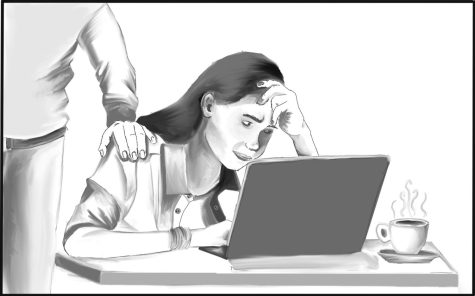Science Department Offers New Anatomy and Physiology Course
The classroom is dark, the only source of light being the big windows on the back wall. Thin rays of light shine through X-ray scans of biological specimens.
A cart stacked with microscopes stands beside the front desk, and charts of polyatomic ions are taped to each lab counter. In the corner, a life-sized skeleton stands upright, almost blending in against the white walls behind.
Sitting behind lab tables, twenty students look at the powerpoint projected on the board, depicting an image of tissue that lines the stomach. The cells are shaped like columns, lined side-by-side to maximize surface area for material exchange.
These students are taking Beachwood’s newest class: honors anatomy & physiology, taught by Alex Paulchell.
Sixty-seven students are enrolled in the course this year, which Paulchell spent the summer preparing for.
“Beachwood is amazing because [I was given] complete liberty to design the course,” he said.
The curriculum is split according to physiological systems of the body—skeletal, muscular, endocrine, and nervous systems among eleven total. Currently, the class is studying the integumentary system that deals with skin.
“It’s a lot of memorization,” junior Talya Berenholz said. “…You realize how complex the human body is, and we’re not even learning all of the details about every single thing.”
“We’re talking about tissue right now, and we’re discussing each tissue type and some diseases that cause the tissue to have some sort of mutation,” she added. “But we’re not even going into detail about how that process works.”
Pauchell uses a standards-based grading system. This means that grades are not assessed by a set of points, but by overall mastery of skills in a specific area or “standard.”
The standards-based grading system is used by other science classes including AP Physics, and the student is allowed to retest a standard they did not master on their first try.
“I assign a lot of homework,” Paulchell said. “…You do as much as you need to in order to learn the content. I have reading sheets and assignments, but it all builds up to labs and tests.”
“I think it’s challenging,” Berenholz said. “It’s different from the other science classes I’ve taken. A lot of other sciences include math and formulas and following a pattern, but in anatomy, there’s no specific pattern.”
The pictures on the board are of epithelial tissue. Paulchell explains what each type of tissue does and where each is found in the body. He shows the class pictures of microscope slides. Students will have a chance to look at the tissues in lab on the next block period.
The examples include stratified columnar, simple squamous and transitional cell structures. Every now and then, he pauses to ask the class a question.
“Where can you find stratified squamous structures in the body?”
“Muscle?” someone guesses.
“Good guess, but no.”
Another student guesses skin, and the class moves on.
The class came into being after the science department obtained approval from Superintendent Dr. Bob Hardis. According to Paulchell, the teachers had to write a course description and decide who would teach the class. It was only after that they could write the course sequence in detail.
“Anatomy & Physiology was one of my favorite courses in high school, so I was very receptive to the idea,” Hardis wrote in an email. “But I wanted to understand its place in our current curriculum sequences.”
Currently, the only requirements for taking honors anatomy & physiology is one year of chemistry and one year of biology.
Hardis had no concerns about getting the class off the ground, and he is willing to consider good ideas for new courses.
“…It was presented in such a way that made it clear how the course fit into our goals for students to have access to multiple high-level science offerings during their time at BHS,” Hardis wrote.
Additionally, Paulchell felt that the introduction of the course would provide a good option for students who may have reason to be uncertain about what high-level science classes to take.
“We asked the district to introduce a new course for a student who is either focusing on other disciplines or doesn’t feel like they’re ready yet for AP sciences,” he said. “Also, I already love teaching the course.”
According to Paulchell, the students are eager to learn and want to be in the class. They can cover a lot of material in the course of the year, but there is no pressure of preparing for AP exams.
This sentiment is echoed among the students.
A small-scaled plastic model of a human body sits on the counter above the skeleton. Removable plastic organs are exposed. Yet another skull perches on Paulchell’s desk.
Honors anatomy & physiology is also unique in that the class engages in hands-on experiments and lab experience. According to Pauchell, students conduct a lab every block period. In order to fully understand anatomical structures, he conducts dissection labs.
“I have individual sheep organs in addition to a plastic model of every organ,” Paulchell said.
Paulchell also has rat cadavers, and the class will be dissecting ethically-sourced cats for their final exam.
Overall, Paulchell feels that the class is a valuable option for BHS students and hopes to continue teaching the class in the future.
“I think it’s a good foundation of knowledge to have,” said Berenholz. “I would totally recommend it. You can go into a lot of fields—medical or nonmedical…. My favorite part of the class is actually Mr. Paulchell. He’s the best.”
“I would say the practical applications of human anatomy will follow you to college or will just help you out in your everyday life,” Paulchell concluded.

Jinle Zhu has been writing for The Beachcomber since her freshman year (2014). She has been the features editor and layout editor. She likes Photoshop...













